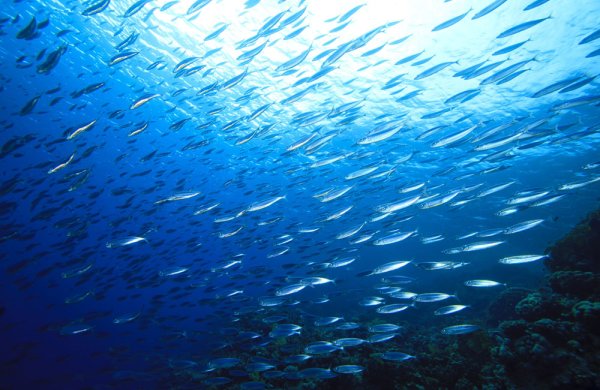
Interview
Using sound to monitor fish
The fishing industry is innovating to become more sustainable. In addition to technical innovations, for instance in fishing gear or new technologies to aid fishing operations, there are also new developments in the field of monitoring fish stocks. Benoît Bergès of Wageningen Marine Research is involved in those developments. His focus lies on sonar-like systems.
“It all starts with data.” That is the position of Benoît Bergès, acoustics researcher at Wageningen Marine Research, when he is talking about fish stocks. “If you don't know how much fish is out there and how it is harvested, there’s no way to know how much you can catch sustainably.”
Bergès uses sonar-like systems, so called echosounders, to monitor schools of fish. The system emits sound waves underwater and records the sounds that is scattered back. “Fish, especially those with a swim bladder, scatter sound very efficiently,” he says. “This acoustic imaging, so called echogram, allows us to track fish schools, determine their size and density, and in specific cases even which species they are comprised of. For example, herring scatters sound differently than mackerel.”
This acoustic imaging, so called echogram, allows us to track fish schools, determine their size and density, and in specific cases even which species they are comprised of.
Bergès and his colleagues study the fish stocks in the North Sea from research vessels. They sail in long straight lines, so-called transects, while using echosounders to monitor fish populations. At certain places they cast a net to see ‘in real life’ which fish are in a certain school. “We do this to check whether we are interpreting echograms correctly. The information from fish samples is also essential to convert the acoustic density of schools into abundance of fish, with a distinction per age and length.”
Innovation in collecting and combining data
There is not much technical innovation potential in these echosounders, Bergès emphasises. “We’re talking about long-term, international surveys,” he says. “So you want the methods to be consistent. You can’t make fundamental changes to the data collection halfway through a sequence.”
The innovation, he says, lies in collecting and combining additional data on the ecosystem. “With new technologies, we can integrate further data collection along the way,” explains Bergès, “for example, concerning temperature, salinity and the seabed. In order to understand the ecosystem better and provide context to what the echosounders tell us, we increasingly combine this data with data from other sources.”

We provide advice for catch and fish quotas
Norwegian colleagues developed a software package, StoX, that helps scientists to process data from scientific surveys efficiently. This aspect is essential when handling and analysing such complex data series. “This software has been a major step forward for scientific surveys,” says the researcher. “We work together with the Norwegians to improve the software, also with colleagues from other countries. Together we think of new functionalities and address bugs in the software.”
In order to provide advice for policy makers, scientists gather yearly to analyse the range of data available on fish stocks. This is typically done during working groups of ICES, the International Council for the Exploration of the Sea. “We use statistical models to investigate population dynamics”, he says. “Such models are able to aggregate a wide range of data, not just acoustic survey data but also, for example, data from larvae surveys, trawl surveys or – more importantly – catch and bycatch data. We combine all that data to estimate the state of a fish stock and the impact of fishing pressure. On that, we base our advice regarding quotas. This is done in the ICES framework every single year.”
Such analyses also invite projections: how will the fish stock develop in the coming years under different fishing scenarios? This helps to determine sensible management strategies.
Fully exploiting the potential of data
In addition, Bergès assists fishers on board in the use of acoustic equipment. “They use echosounders at different frequencies,” he says. “The new generation of echosounders are able to work in broadband, which offers the potential to determine fish species composition more accurately. We have developed software that helps fishers to interpret this type of data. This way we hope to help them to fish in a more targeted way, with less by-catch and less fuel consumption.”
Innovation also lies in the area of data processing. “Many terabytes of data are collected every year. It would take one person many years to fully exploit its potential”, says Bergès. “Processing is challenging due to the complexity of the data. We are now working on artificial intelligence to automatically process that data, but there’s still work to be done.”
Another challenge is the fact that fishing vessels don't sail along transects like researchers do during scientific surveys. They are always trawling in different places, which creates a bias that needs to be accounted for. “However, combining industry data with scientific data has great potential to help us monitoring fish stocks more efficiently. That is a very promising field.”
Working together with fishermen
Cooperation with the fisheries sector is indispensable. “We help to make the sector more sustainable with advice on quotas and provide fishers with potential tools”, says Bergès, “and vice versa, they supply us with large amounts of quality data. Together we are making estimates of fish stocks more accurate, and fisheries more efficient.”
We help to make the sector more sustainable with advice on quotas and provide fishermen with potential tools.
Despite clear challenges, Bergès sees significant progress. “More and more useful data is emerging, including, for example, about data-poor fish stocks”, he says. And I’m sure those developments will only accelerate in the coming years – so I see all kinds of great developments ahead.”